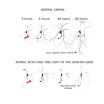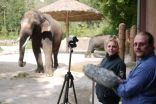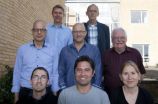(Press-News.org) A gene that is associated with regeneration of injured nerve cells has been identified by scientists at Penn State University and Duke University. The team, led by Melissa Rolls, an assistant professor of biochemistry and molecular biology at Penn State, has found that a mutation in a single gene can entirely shut down the process by which axons -- the parts of the nerve cell that are responsible for sending signals to other cells -- regrow themselves after being cut or damaged. "We are hopeful that this discovery will open the door to new research related to spinal-cord and other neurological disorders in humans," Rolls said. The journal Cell Reports will publish an early online copy of the paper on 1 November, and also will include the paper in the monthly issue of the journal, which will be published on 29 November 2012.
Rolls explained that axons, which form long bundles extending out from nerve cells, ideally survive throughout an animal's lifetime. To be able to survive, nerve cells need to be resilient and, in the event of injury or simple wear and tear, some can repair damage by growing new axons. Earlier research from Rolls and others suggested that microtubules -- the intracellular "highways" along which basic building blocks are transported -- might need to be rebuilt as an important step in this type of repair. "In many ways this idea makes sense: in order to grow a new part of a nerve, raw materials will be needed, and the microtubule highways will need to be organized to take the new materials to the site of growth," Rolls said. The Rolls team therefore started to investigate the role of microtubule-remodeling proteins in axon regrowth after injury. In particular, the team members focused on a set of proteins that sever microtubules into small pieces. Out of this set, a protein named spastin emerged as a key player in axon regeneration.
"The fact that the spastin protein plays a critical role in regeneration is particularly intriguing because, in humans, it is encoded by a disease gene called SPG4," Rolls explained. "When one copy of this gene is disrupted, affected individuals develop hereditary spastic paraplegia (HSP), which is characterized by progressive lower-limb weakness and spasticity as the long-motor axons in the spinal cord degenerate. Thus, identifying a new neuronal function for spastin may help us to understand this disease."
To study the role of spastin, Rolls and her team chose the fruit fly as their model organism. "On the molecular level, many of the processes associated with nerve-cell growth and regrowth are the same in humans as in fruit flies," Rolls said. "And, like all other animals including humans, fruit flies have two copies of every gene -- one from each parent -- so different combinations of each gene can lead to different observable traits." The team members bred three genetically distinct groups of fruit flies in the laboratory to observe how various spastin gene combinations might affect the behavior of nerve cells after injury. The first group of flies had two normal copies of the gene; the second had one normal copy and one mutant copy; while the third had two mutant copies. Then, in all three groups, the scientists cut the axons of the flies' nerve cells and observed the regeneration process.
"In fruit flies with two normal copies of the gene, we observed that severed axons elegantly reassembled themselves. This process is supposed to take place if the fly is to heal from nerve trauma since life events, as well as wear and tear, tend to cause such damage," Rolls said. "But, interestingly, in the other two groups -- the fruit flies with two or even one abnormal spastin gene -- there was simply no regrowth, indicating that what we have here is a dominant problem." Rolls explained that dominant diseases arise when only one copy of a disease gene is disrupted. For example, Huntington's Disease in humans is a dominant disease because people who have inherited a normal gene from one parent and an abnormal gene from the other parent still become ill. Meanwhile, cystic fibrosis is a recessive disease: people with at least one normal gene copy do not manifest the disease at all.
The scientists also found that an impaired spastin gene affected only how the axons regrew after being severed. That is, the gene did not seem to play a role in the developmental stage when axons were being assembled for the first time. In addition, the researchers found that, while the gene affected the flies' axons, their dendrites -- the parts of the neuron that receive information from other cells and from the outside world -- continued to function and repair themselves normally.
"Now that we know that spastin plays an important role in axon regeneration and also that this gene is dominant, we have opened up a possible path toward the study of human diseases involving nerve-cell impairment," Rolls said. "In fact, our next step is to probe the link between hereditary spastic paraplegia (HSP) and axon regeneration." Rolls added that the SPG4 gene that encodes human spastin is only one of the disease genes associated with HSP, so she and her colleagues now are testing whether other disease genes also play a role in nerve-cell regeneration.
INFORMATION:
In addition to Rolls, other researchers who contributed to this study include Michelle C. Stone, Kavitha Rao, Kyle W. Gheres, Seahee Kim, Juan Tao, Caroline La Rochelle, and Christin T. Folker from Penn State; and Nina T. Sherwood from Duke University.
The research was funded by the Spastic Paraplegia Foundation; the National Institutes of Health through its National Institute of Neurological Disorders and Stroke, and its National Institute of General Medical Sciences; and the Pew Scholars in the Biomedical Sciences.
[ Katrina Voss ]
CONTACTS
Melissa Rolls: 814-867-1395, mur22@psu.edu
Barbara Kennedy (PIO): 814-863-4682, science@psu.edu
IMAGE
A high-resolution image associated with this research is online at http://www.science.psu.edu/news-and-events/2012-news/Rolls11-2012.
IMAGE CAPTION
In fruit flies with two normal copies of the spastin gene, Rolls and her team found that severed axons were able to regenerate. However, in fruit flies with two or even only one abnormal spastin gene, the severed axons were not able to regenerate.
IMAGE CREDIT
Rolls lab, Penn State University
GRANT NUMBERS
NINDS (R21 NS066216 and R01 NS63896) and NIGMS (R01 GM085115)
Gene required for nerve regeneration identified
2012-11-01
ELSE PRESS RELEASES FROM THIS DATE:
A glimpse into neurosurgical risk prevention and the surgical checklist
2012-11-01
Charlottesville, VA (November 1, 2012). The November issue of Neurosurgical Focus is dedicated to lessening the number and severity of adverse events surrounding neurosurgical intervention for a variety of disorders. Guest editors Alexander Khalessi (University of California, San Diego), James Forrest Calland (University of Virginia), Gabriel Zada (University of Southern California), and Michael Y. Wang (University of Miami Health System) selected 16 articles on systems-based quality improvement for neurosurgical procedures.
The articles are divided into four major subtopics: ...
An elephant that speaks Korean
2012-11-01
An Asian elephant named Koshik can imitate human speech, speaking words in Korean that can be readily understood by those who know the language. The elephant accomplishes this in a most unusual way: he vocalizes with his trunk in his mouth.
The elephant's vocabulary consists of exactly five words, researchers report on November 1 in Current Biology, a Cell Press publication. Those include "annyong" ("hello"), "anja" ("sit down"), "aniya" ("no"), "nuo" ("lie down"), and "choah" ("good"). Ultimately, Koshik's language skills may provide important insights into the biology ...
JCI early table of contents for Nov. 1, 2012
2012-11-01
Congenital diarrheal disorder linked to a mutation in DGAT1
Congenital diarrheal disorders (CDD) are a group of rare intestinal diseases that are caused by genetic mutations. In a study published in the Journal of Clinical Investigation, Robert Farese and colleagues at the University of California, San Francisco, identified a family with two of three children affected by CDD. The affected children both carried a rare mutation in the DGAT1 gene. DGAT1 mediates the formation of triglycerides and is being assessed as a therapeutic target in the treatment of obesity. The study ...
Congenital diarrheal disorder linked to a mutation in DGAT1
2012-11-01
Congenital diarrheal disorders (CDD) are a group of rare intestinal diseases that are caused by genetic mutations. In a study published in the Journal of Clinical Investigation, Robert Farese and colleagues at the University of California, San Francisco, identified a family with two of three children affected by CDD. The affected children both carried a rare mutation in the DGAT1 gene. DGAT1 mediates the formation of triglycerides and is being assessed as a therapeutic target in the treatment of obesity. The study by Farese's group suggests that targeting of DGAT1 could ...
Feedback loop maintains basal cell population
2012-11-01
HOUSTON - (Nov. 2, 2012) – Notch – the protein that can help determine cell fate – maintains a stable population of basal cells in the prostate through a positive feedback loop system with another key protein – TGF beta (transforming growth factor beta), said Baylor College of Medicine researchers in the journal Cell Stem Cell.
"When basal cell homeostasis (or maintenance of a stable population) is disrupted, it may be part of the process that initiates prostate cancer," said Dr. Li Xin, assistant professor of molecular and cellular biology at BCM and a senior author ...
Rice team boosts silicon-based batteries
2012-11-01
HOUSTON – (Nov. 1, 2012) – Researchers at Rice University have refined silicon-based lithium-ion technology by literally crushing their previous work to make a high-capacity, long-lived and low-cost anode material with serious commercial potential for rechargeable lithium batteries.
The team led by Rice engineer Sibani Lisa Biswal and research scientist Madhuri Thakur reported in Nature's open access journal Scientific Reports on the creation of a silicon-based anode, the negative electrode of a battery, that easily achieves 600 charge-discharge cycles at 1,000 milliamp ...
Stem cells show promise for treating infertility in cancer patients
2012-11-01
AUDIO:
This is an audio clip of Deborah Sweet of Cell Stem Cell interviewing Dr. Kyle Orwig of the University of Pittsburgh School of Medicine regarding his recent preclinical study "Spermatogonial...
Click here for more information.
A promising stem-cell-based approach for treating infertility has been successfully demonstrated in non-human primates, as reported in a study published by Cell Press in the November issue of the journal Cell Stem Cell. The preclinical study ...
Meth vaccine shows promising results in early tests
2012-11-01
LA JOLLA, CA – Scientists at The Scripps Research Institute (TSRI) have performed successful tests of an experimental methamphetamine vaccine on rats. Vaccinated animals that received the drug were largely protected from typical signs of meth intoxication. If the vaccine proves effective in humans too, it could become the first specific treatment for meth addiction, which is estimated to affect 25 million people worldwide.
"This is an early-stage study, but its results are comparable to those for other drug vaccines that have then gone to clinical trials," said Michael ...
Predicting what topics will trend on Twitter
2012-11-01
CAMBRIDGE, Mass. -- Twitter's home page features a regularly updated list of topics that are "trending," meaning that tweets about them have suddenly exploded in volume. A position on the list is highly coveted as a source of free publicity, but the selection of topics is automatic, based on a proprietary algorithm that factors in both the number of tweets and recent increases in that number.
At the Interdisciplinary Workshop on Information and Decision in Social Networks at MIT in November, Associate Professor Devavrat Shah and his student, Stanislav Nikolov, will present ...
Plants recognise pathogenic and beneficial microorganisms
2012-11-01
Plant roots are surrounded by thousands of bacteria and fungi living in the soil and on the root surface. To survive in this diverse environment, plants employ sophisticated detection systems to distinguish pathogenic microorganisms from beneficial microorganisms.
Here the so-called chitin molecules from microorganisms, along with modified versions, play an important role as they are detected by the plant surveillance system. Legumes, for example, build a defence against pathogenic microorganisms in response to simple chitin molecules.
However, when the plant detects ...



